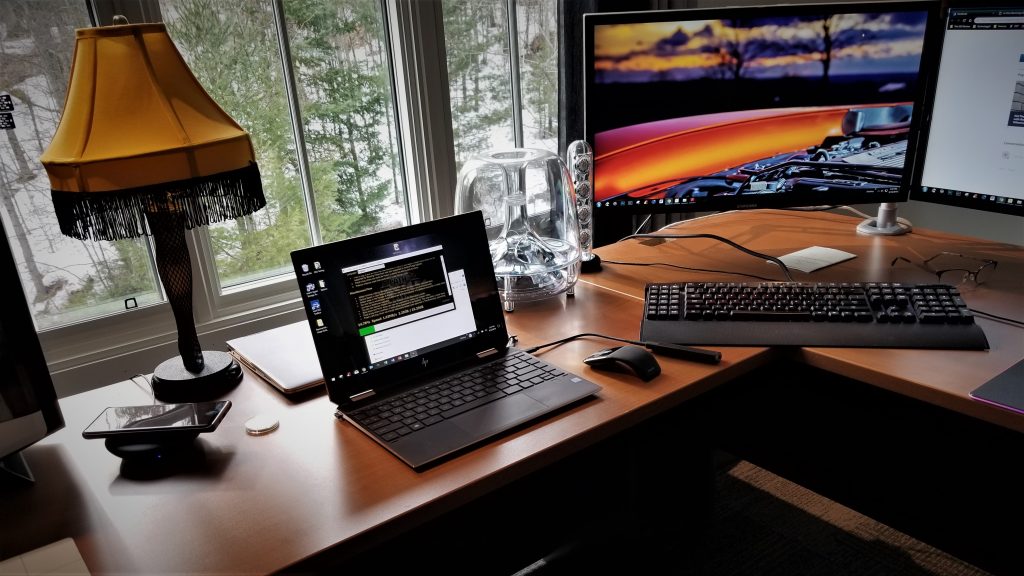INTEL OPTANE H10 COMPATIBILITY
At this time, the Intel H10 is only supported by 8th Gen and newer Intel Core processors and requires PCIe 3.0, NVMe 1.1 and IRST 17.2 or later, along with Windows 10. You won’t be seeing this in a Mac anytime soon and it won’t work on just any motherboard. We might suggest trying a 300-series motherboard with the latest update or a system with an 8th Gen Core U-Series CPU. The reason for this is because the H10 requires bifurcation where two lanes of the 4-lane PCIe are used for the Optane while two are used for the QLC SSD. ‘Bifurcation – the division of something into two branches or parts’.
TSSDR TEST BENCH AND PROTOCOL
Typically, we might list our optimization of our Test Bench to achieve the highest marks possible, but this review is slightly different. The Test Bench in use today is a 2019 HP Spectre X360 13″ ultrabook which contains an Intel Core i7-8565U Processor (8M Cache, Up to 4.6GHz) and 16GB of DDR3 RAM at 2133MHz…with the Intel H10 512GB SSD for storage. The ONLY optimization that we have done for our testing today is that we set the system from ‘Balanced’ to ‘High Performance’ mode, as well as checking ‘Turn off write-cache buffer flushing on this device’ in Device Manager/Disk Drives/Intel/Policies for synthetic benchmark testing.
Somewhat interesting perhaps is the fact that this just may be the first time Intel IRST has been used for a Optane PCIe 3.0 NVMe SSD, as it was originally intended for SATA SSDs. I am admittedly a fan of the HP Spectre, not only because it is a fully convertible touch screen ultrabook, but also, the build quality is beyond reproach with its dark ash aluminum color with gold edging.
You might notice the 15″ twin Spectre X360 just behind this one and we cant wait to test this ultrabooks claim of 22.5 hrs battery life which is reduced slightly to 17 hrs with the Intel Optane H10 working its magic inside this system. Check out HP Spectre X360 pricing at Amazon.
TESTING METHODOLOGY
For our testing today…we are going to deviate from things just a bit. Although we will include a few of our typical synthetic tests as well as a bit of true testing and even PCMark testing, we are also going to run a regimen that was suggested by Intel to ‘show off’ if you will, the disk caching of the new Optane. With that, Intel also supplied a new Intel 760P 512GB NVMe SSD to base comparison tests of the H10 on.
I guess a more realistic comparison might have been the 660P as that is a QLC SSD and very much the twin of the QLC NAND/SMI controller portion of this test, which is why our synthetic testing will definitely be a bit interesting as we will look at Optane enabled, Optane Disabled and 760P results in some tests.
TYPICAL USAGE SCENARIOS WITH BACKGROUND ACTIVITY
For this phase of testing, GIMP, Excel, PowerPoint, Word are started with very large files, all the while a 15GB video is being copied to another disk location in the background. As well, an instance of the Path of Exile is launched with the same background activity on its own test. In all cases, there were ten instances of each test completed with the computer restarted and remaining idle for 5 minutes between each test, the last four results being averaged for the final time. This phase of testing is suggested to demonstrate just how effective the Optane Disk Cache of the H10 is when compared to a premium SSD such as the 760P.
These results speak for themselves and we were actually very surprised, considering that we are comparing the H10 to an SSD that transfers data faster than 3GB/s. In every instance, the Optane H10 bettered the start times of the Intel 760p, and typically by significant margins. This is a great start and validation that the user system gets faster over time as the H10 adapts to common computing activities and stores that ‘hot data’ within the Optane portion of this SSD.
PCMARK 3DMARK GRAPHICS BENCHMARK COMPARISON
3DMark Sky Diver is a DirectX 11 benchmark for gaming laptops and mid-range PCs. Use 3DMark Sky Diver to benchmark systems with mainstream graphics cards, mobile GPUs, or integrated graphics. It is especially suitable for DirectX 11 systems that cannot achieve more than single-digit frame rates in the more demanding Fire Strike test. Sky Diver is only available in the Windows editions at this time.
In this test, there were no repeated runs to establish a disk cache.
 The SSD Review The Worlds Dedicated SSD Education and Review Resource |
The SSD Review The Worlds Dedicated SSD Education and Review Resource | 


“In this test [PCMARK], there were no repeated runs to establish a disk cache. It was a single run where the H10 Optane bettered the Intel 760P NVMe SSD in three of four tests, although all were very close.”
The numbers pictured say that the 760p is better in 3 of the 4 tests, not the other way around, did you input things backwards?
Odd and I removed that statement. Thank you. When time permits, we will be rerunning this test.
Optane only works with Intel compatible motherboards etc.
That sucks big time. Very limited in what hardware it will work with.
Exactly like Apple. I’m waiting for Samsung and others to catch up.
Optane like many Intel products are over hyped and over priced just like nvidia.
Valid points. Thank you.
How did it affect system bootup times?
System boot times were faster, keeping in mind that they are already fast for an SSD. Boot time is one of the areas that increase as hot data is saved.